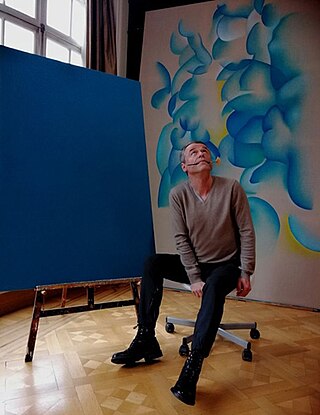
Roppongi is a district of Minato, Tokyo, Japan, famous for the affluent Roppongi Hills development area and popular night club scene. A few foreign embassies are located near Roppongi, and the night life is popular with locals and foreigners alike. It is in the central part of Tokyo, south of Akasaka and north of Azabu.

Roppongi Hills is a development project in Tokyo and one of Japan's largest integrated property developments, located in the Roppongi district of Minato, Tokyo.

Minoru Mori was considered to be one of Japan's most powerful and influential building tycoons. He joined the real estate business of his father, Taikichiro Mori, after graduating from the University of Tokyo and was president and CEO of Mori Building, of which he and his older brother Kei's families owned 100%. He owned 12.74% of Sunwood Corporation.

Roppongi Hills Mori Tower is a 54-story mixed-use skyscraper in Roppongi, Minato, Tokyo, Japan. Completed in 2003 and named after builder Minoru Mori, it is the centerpiece of the Roppongi Hills urban development. It is the sixth-tallest building in Tokyo at 238 meters (781 ft). The tower has a floor space area of 379,408 square meters, making it one of the largest buildings in the world by this measure.

David Stuart Elliott is a British art gallery and museum curator and writer on modern and contemporary art. He is also a Contributing Editor of Ran Dian magazine.

Maman (1999) is a bronze, stainless steel, and marble sculpture in several locations by the artist Louise Bourgeois. The sculpture, which depicts a spider, is among the world's largest, measuring over 30 ft high and over 33 ft wide (9.27 x 8.91 x 10.24 metres). It includes a sac containing 32 marble eggs and its abdomen and thorax are made of rubbed bronze.
The Tokyo Metropolitan Art Museum is a museum of art located in Ueno Park, Tokyo, Japan. It is one of Japan's many museums which are supported by a prefectural government. The first public art museum in Japan, it opened in 1926 as the Tokyo Prefectural Art Museum and was renamed in 1943 after Tokyo became a metropolitan prefecture. The museum's current building was constructed in 1975 and designed by modernist architect Kunio Maekawa, remaining one his most well-known works today.

Fumio Nanjo is a curator and art historian. Between 2006 and 2019 he was the director of the Mori Art Museum in Tokyo. A graduate of Keio University, Nanjo was previously Director of the Institute of Contemporary Arts in Nagoya (1986–1990) and served as commissioner of the Japan Pavilion at the Venice Biennale (1997).

Guillaume Bottazzi is a French visual artist.

Mori Building Company, Limited is a Japanese family-owned property management firm. As of 2015 its president and CEO is Shingo Tsuji. Its headquarters are in the Roppongi Hills Mori Tower in Roppongi, Minato, Tokyo.
Mami Kataoka is a Japanese art curator and writer. She is presently the director of the Mori Art Museum in Tokyo.
Tenmyouya Hisashi is a Japanese contemporary artist.
Tsubasa Kato is a Japanese contemporary artist. He made his debut at the "Roppongi Crossing 2010" exhibition at Mori Art Museum, Tokyo and received the Kengo Kuma Prize, after earning M.F.A from the Tokyo University of the Arts. In 2015, he received a fellowship from the Agency for Cultural Affairs of Japan Government and participated in Japan-US Exchange Friendship Program in the Arts as Visitor Research Scholar of University of Washington in Seattle for two years. Since 2007, he is known for his Pull and Raise project.

Rei Naito is a Japanese artist. Naito's work intersects with minimalism, conceptual art, and environmental art, exploring the ways in which human existence is shaped, felt, and made evident amidst its natural surroundings. Using organic and found materials and creating immersive environments that interact with sound, light, and atmosphere, Naito's practice takes a strong interest in the intimate, ambient, and often transient encounters that arise between individuals and artworks.
Makoto Azuma is a Japanese flower artist, botanical sculptor, and co-founder of JARDINS des FLEURS.
Shizuka Yokomizo is a Japanese photographer and installation artist.

Ginza Six is a luxury shopping complex located in the Ginza area of Tokyo, jointly developed by Mori Building Company, J. Front Retailing, Sumitomo Corporation and L Catterton Real Estate. The name Ginza Six or G Six reflects the building address in Ginza 6-chome as well as the desire to provide an exceptional "six-star" shopping experience.

Yoshinori Niwa is a Japanese artist currently based in Vienna, Austria. His practice primarily consists of social interventions performed in public spaces, as well as mediums in video, performance, and installation. Niwa's art often carries humorous and provocative undertones, employing direct and slogan-like titles to explore and critique contemporary societal and capitalist structures. His work investigates collective behavior, social norms, and political themes, sometimes drawing on the absurd to challenge established systems.
Bang Nhat Linh is a Vietnamese contemporary artist based in Hanoi. His works are usually simple but multi-layered, dreamy and humane. They reflect the surveys into the depths of the psychological spaces, memories, history, submerged and of the oblivion in which "war memorabilia are removed from their original contexts to be placed within another context, or positioned in a relationship with human as communicable and interactive objects.

TeamLab is an international art collective, an interdisciplinary group of artists formed in 2001 in Tokyo, Japan. The group consists of artists, programmers, engineers, CG animators, mathematicians and architects who refer to themselves as “ultra-technologists". TeamLab creates artworks using digital technology. Since 2014 TeamLab is represented by Pace Gallery.













